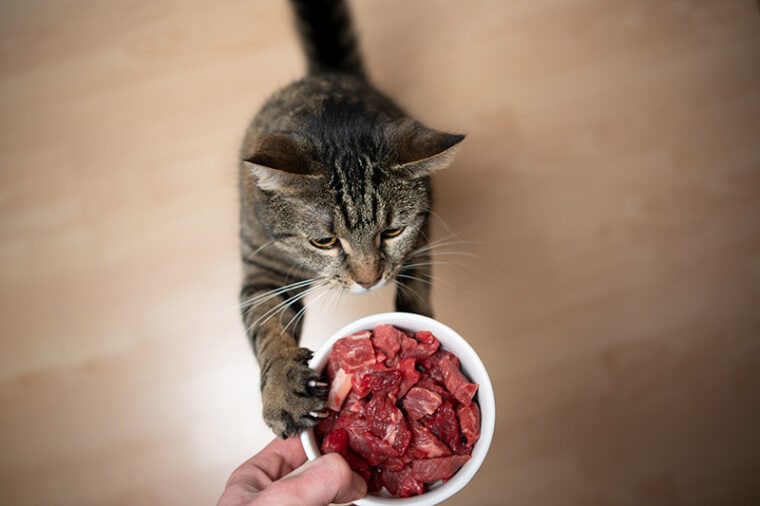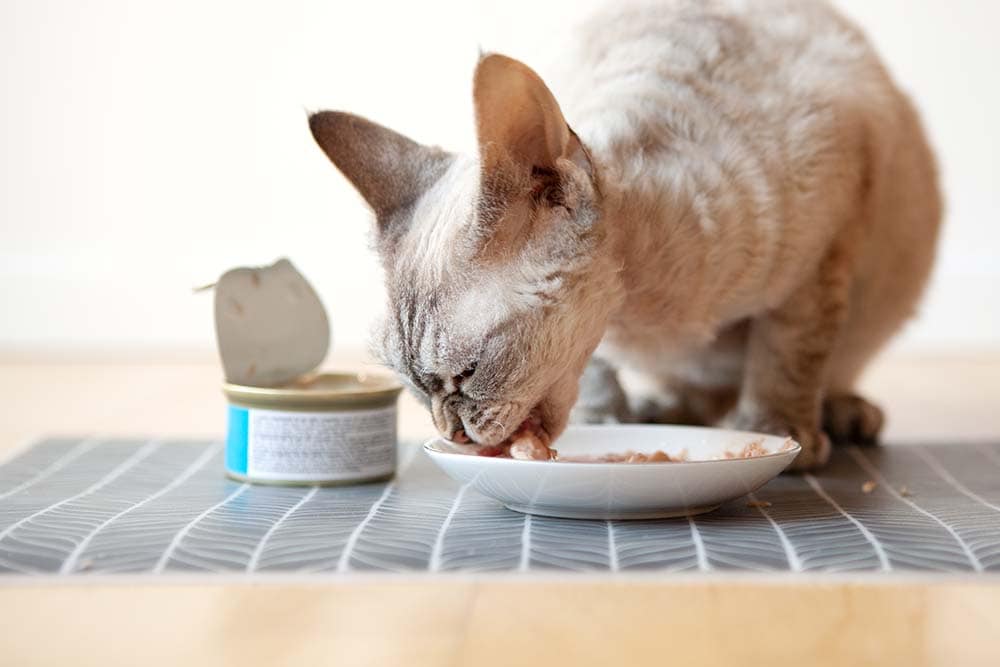
Transitioning to a new cat food can be a trying experience for both kitty and cat owner. This is especially true when switching to a raw food diet because it is so different from canned food, and especially, most commercially available kibble options.
In the majority of cases, cats will be excited by the new smells and textures offered by a raw diet, but others can be more suspicious of change.
Below, we have 10 tips to help you make this transition process smoother for both of you. We recommend that you speak to your veterinarian before switching diets, and you can also read more about the pros and cons of a raw cat food diet here.
The 10 Tips on How to Transition Your Cat to a Raw Food Diet
1. Switch to Canned Food First

If your kitty is not already eating canned food, switching to it before transitioning to raw food can help make the process easier. This is because wet canned food is much more similar to raw food than dry kibble, and shares many qualities, such as flavor profiles and textures. This process of transitioning to canned food first allows you to start getting a sense of what flavors your cat likes as well, such as fish over poultry, which can be useful information when choosing the best raw food diet for them later.
Cats that have never eaten canned food may be averse to this change at first, but you can follow many of the same steps below to help ease them into it.
2. Try Scheduled Feeding
Many cat owners leave dry kibble out for their cats at all times. This doesn’t work for a raw food diet, as raw food can only be fed in specific portions and left out for a short period before it goes bad. It’s important to transition your cat to a feeding schedule as soon as possible, so they adjust to eating raw food when it’s given. Most cats should eat twice a day, once in the morning and once in the evening.
Be sure to follow the portioning instructions for whatever food you are feeding them at the time and adjust this when changing their food source to avoid weight loss or gain.
3. Use Freeze-Dried Raw Food

Freeze-dried raw food is raw food that has been dried into a pellet form. For cats that have never eaten canned food, this form may be easier to transition to, as it more closely resembles kibble. These pellets are often larger and softer than kibble, however, so aren’t an exact match, so your kitty may still turn their nose up at it at first. One good thing about this option is that it can easily be mixed in with their current kibble diet to help them adjust slowly.
There are also freeze-dried food toppers that are designed to be added to an existing diet but do not offer enough nutrition to be the only food source.
4. Smear Food on Their Paw
Cats are clean animals by nature and will lick off any substance that finds its way onto their coat. You can use this to your advantage if you are smart about it. If your kitty won’t try any of the new wet food (or canned food if you are transitioning to that first), try smearing a small amount onto the top of each paw. They will not like that their paw is dirty with this unacceptable substance and will try to clean it off, eating the food in the process.
Once they realize this is food that they like, they may then seek out this food when it is offered at regular mealtimes. Sometimes, this is all it takes to get them to try it.
5. Hide the Food (for Hunting)
Cats are hunters and will be curious about new things, especially new smells, in their environment. The first time you introduce raw food to your cat, you may choose to hide a small amount of it somewhere in the home. Under the bed or behind the couch are two excellent locations where they can sniff out the new scent and go looking for it. Once they’ve located it, they may be more interested in this new food simply because they had to go looking for it and give it a try.
This can be done more than once, so long as you place the food in a different location each time.
6. Slightly Warm (But Don’t Cook) the Food

Warming up the food will create a stronger smell, which could attract your cat’s attention and entice them to try it. This may work for canned food as well as raw food. However, when warming up raw food, be sure not to warm it up so much that you end up cooking it. Raw food is formulated for the best nutrition in its current state and cooking it may disrupt the carefully planned balance of nutrients.
If you’ve decided to hide the raw food and your cat can’t seem to find it, try warming it up a little before hiding it. The stronger scent could be what’s needed to draw them in.
7. Find Their Taste Preference
Just like there are some foods you don’t like and may even refuse to eat, your cat has their own food preferences. Most cat foods, including raw ones, come in fish, poultry, red meat, and game (such as rabbit or venison). If possible, get a bit of each one so you can try them out. If your cat turns up their nose at fish but devours the rabbit flavor, you know that it’s not necessarily the raw food that they don’t like but just the flavor you were offering them.
Once you find out what options they like best, you can continue with the confidence that you are feeding them food they enjoy.
8. Experiment with Texture

Sometimes it’s not only about the flavor of the food but the texture of it. Cat foods, including raw ones, may come in a variety of textures, including pate, chunks, shreds, gravy, broth, and more. You may even decide to add toppers such as a sauce or gravy to their raw food to change the texture. This can be done for cats who already eat raw food but seem to get bored with their diet day after day and need a change of pace.
However, it’s also a great technique for transitioning cats from kibble to canned food or from any food to raw food. Once you have an idea of their texture preferences, you can cater to them.
9. Reduce the Options
When transitioning to any new food, you should always introduce the new food slowly. However, in the case of transitioning to raw food, it can be better to alternate the foods rather than give them together. Your cat is more likely to try the new diet if there is nothing else on offer.
Once they are used to being fed twice a day, offer the raw diet at night, and their old food in the morning, for a period of a week. If they refuse to eat the raw food, you can try out different flavors/textures the next night, but don’t offer an alternative for that particular meal. Missing a meal will not do any harm, and will make them more inclined to try the next offering.
Be sure to only leave the raw food out for 30 minutes at a time.
10. Don’t Hover

Any cat that’s had medication hidden in their food can be suspicious when offered something new, especially if their human is hovering nearby, watching. Once you’ve put the raw food down, don’t make a fuss, just walk away as you normally would after feeding them, returning after 30 minutes to pick up the (hopefully empty) bowl.
If you have multiple cats and need to watch who’s eating what, try to do it from a distance.
Conclusion
If you’re ready to transition your kitty to a raw food diet, give some or all of the tips provided above a try. We are sure they will make a big difference for both you and your kitty as they learn to like their new food source. Remember to follow the advice of their veterinarian when deciding what diet is best for your cat and to ensure they get the nutrition they need for their breed, age, size, and activity level.
If your cat simply refuses to eat any raw offerings, don’t force it. Talk to your veterinarian about other ways to make sure your kitty is getting the best nutrition and enrichment they can.
Featured Image Credit: Nils Jacobi, Shutterstock







